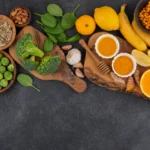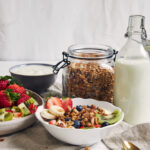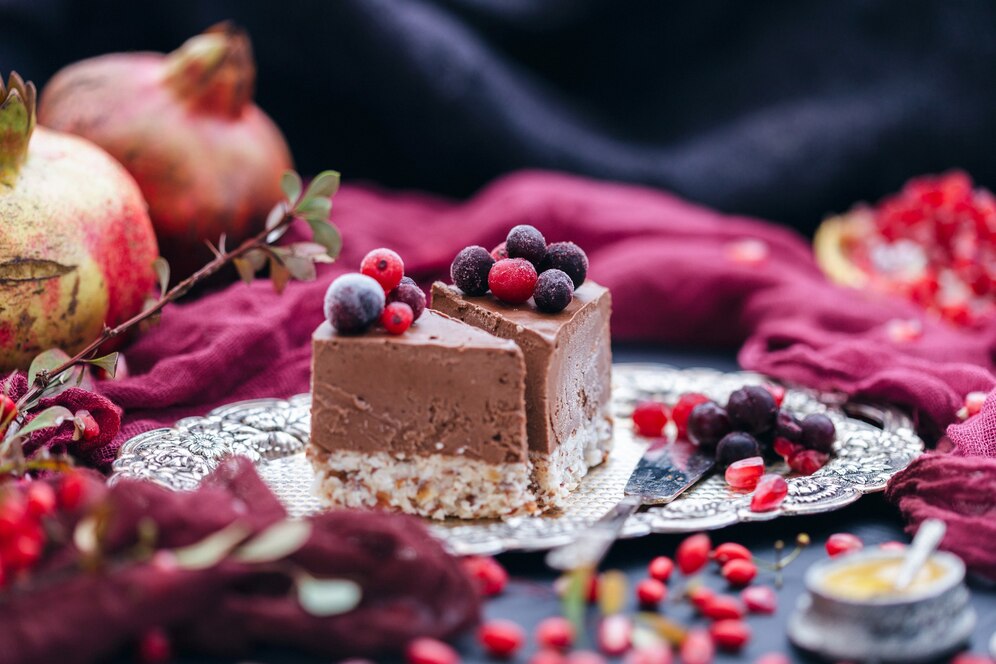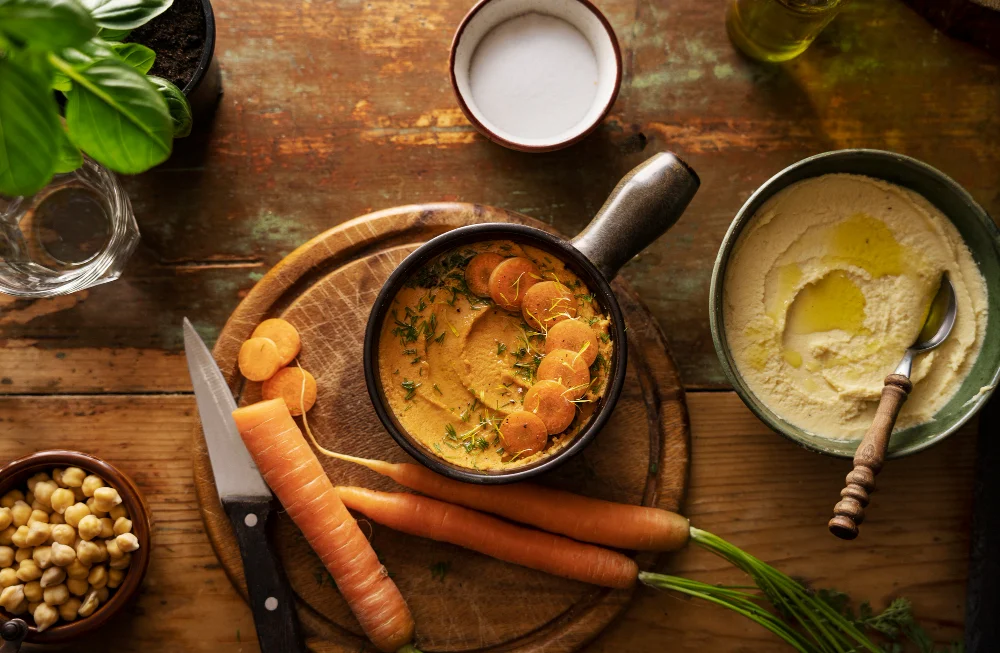Chocolate. The word itself evokes feelings of pleasure, comfort, and pure indulgence. For many, the most decadent chocolate creations – rich mousses, creamy truffles, fudgy cakes – seem inextricably linked to dairy ingredients like butter, cream, and milk. But does embracing a vegan lifestyle mean sacrificing this deep, dark delight? Absolutely not! Welcome to the world of decadent vegan chocolate recipes, where plant-based ingredients transform into luxurious treats that satisfy even the most discerning chocoholic. This guide explores how to create truly indulgent vegan chocolate desserts, viewed through the lenses of nutrition, ethical considerations, ingredient science, environmental impact, and practical recipes perfect for home kitchens in across India.
LENS 1: Nutritional Analysis (Mindful Chocolate Indulgence)

While undeniably treats, vegan chocolate desserts offer unique nutritional nuances compared to their dairy-laden counterparts, allowing for more mindful indulgence.
- The Power of Cacao: The star ingredient, chocolate (derived from cacao beans), offers benefits, especially in darker forms:
- Antioxidants: Dark chocolate (with high cacao percentages, e.g., 70%+) is rich in flavonoids, powerful antioxidants that combat cellular damage. Cocoa powder also retains many of these benefits.
- Minerals: Cacao is a good source of minerals like magnesium, iron, copper, and manganese.
- Vegan Status: Pure dark chocolate (cocoa solids, cocoa butter, sugar) is often naturally vegan. Always check labels for milk solids, milk fat, whey, or lactose. Vegan ‘milk’ and white chocolates use plant-based milk powders (rice, soy, oat) instead of dairy.
- Fats for Richness: Decadence often comes from fat:
- Coconut Oil/Cream: Provides intense richness and a firm set when cold (great for truffles, some frostings). High in saturated fat. Widely available in India.
- Cashew Cream: Blended soaked cashews (kaju) offer creaminess with healthier monounsaturated fats and minerals. Requires a good blender; cashews can be costly.
- Avocado: Creates incredibly smooth, rich textures in mousses and puddings, contributing monounsaturated fats and fiber. Needs strong chocolate flavour to mask its taste.
- Vegan Butter/Cocoa Butter: Used in baking and some frostings for specific textures. Check ingredients of vegan butters for palm oil/hydrogenated fats.
- Benefit: All vegan options contain zero dietary cholesterol.
- Sweeteners & Sugar:Homemade recipes allow control over sugar levels and type. Options beyond refined white sugar (check if bone-char free, less common issue with Indian sugar) include:
- Jaggery (Gur): Adds a local, molasses-like flavour popular in India.
- Date Paste/Syrup: Provides sweetness along with fiber and minerals.
- Maple Syrup/Agave Nectar: Liquid sweeteners offering different flavour profiles.
- Remember, these are still sugars; use mindfully.
- Other Ingredients: Recipes might include nuts, seeds, fruits (berries, bananas), or whole grain/GF flours (in cakes/cookies), adding fiber and micronutrients. When choosing chocolate for a vegan recipe, how does opting for a higher cacao percentage impact both the flavour intensity and potential nutritional benefits?
Nutritional Deep Dive: Dark Chocolate Power – Antioxidants & Minerals
The health buzz around chocolate primarily relates to dark chocolate with high cacao content (70% or more). Cacao beans are rich in flavonoid antioxidants, particularly flavanols like epicatechin. These compounds have been linked to:
- Improved Blood Flow: May help relax blood vessels.
- Heart Health Benefits: Potential positive effects on blood pressure and cholesterol levels (as part of a balanced diet).
- Brain Function: Some studies suggest links to improved cognitive function.
- Mineral Content: Dark chocolate provides significant amounts of iron, magnesium, copper, and manganese per serving. While still high in calories and fat, choosing high-quality dark chocolate for vegan desserts offers these added nutritional perks alongside intense flavour.
Voice of Experience (Nutrition-Focused Pastry Chef): “Vegan chocolate desserts can absolutely be decadent and mindful. I love using high-cacao dark chocolate for its intense flavour and antioxidant boost. Pairing it with avocado or cashew cream provides richness from healthier fats than butter/dairy cream. Using dates or minimal jaggery for sweetness allows the chocolate flavour to truly shine. It’s about quality ingredients, balanced indulgence.” – Chef Anita Sharma, “Plant-Based Delights”
LENS 2: Ethical Framework (Compassionate Cacao)

Indulging in vegan chocolate involves ethical considerations extending beyond dairy avoidance to the very source of the cacao itself.
- Dairy-Free Decadence: The fundamental ethical choice is enjoying rich chocolate treats without supporting the dairy industry. This provides immediate peace of mind for vegans.
- The Ethics of Cacao: The chocolate industry globally faces significant ethical challenges:
- Child Labour & Unfair Wages: Common in major cacao-growing regions (primarily West Africa). Farmers often live in poverty despite chocolate being a multi-billion dollar industry.
- Deforestation: Cacao farming can contribute to deforestation and biodiversity loss if not managed sustainably.
- Choosing Ethical Chocolate: This is crucial for truly compassionate indulgence. Look for certifications:
- Fair Trade: Ensures farmers receive a minimum price and a premium for community development. (Look for Fairtrade International logo).
- Rainforest Alliance / UTZ: Focus on environmental sustainability and farmer well-being (merged certification).
- Direct Trade / Bean-to-Bar: Smaller companies often build direct relationships with farmers, paying higher prices and ensuring quality/ethics (requires research into the specific brand’s practices).
- Organic: Addresses pesticide use and environmental health.
- Packaging Waste: Chocolate bars, chips, and cocoa powder often come in non-recyclable or excessive packaging. Choose brands with minimal/recyclable/compostable packaging or buy cocoa/chips in bulk where possible.
- Sharing Ethical Treats: Offering guests decadent desserts made with ethically sourced, dairy-free chocolate is a powerful statement – demonstrating that indulgence can align with deep care for people, planet, and animals. How does learning about cacao sourcing issues influence your choice of vegan chocolate brands?
Hidden Benefits: Supporting Positive Change
Purchasing certified ethical vegan chocolate actively supports better livelihoods for cacao farmers and promotes more sustainable agricultural practices, turning your treat into a small act of positive global impact.
Voice of Experience (Ethical Consumer Advocate): “For truly ethical vegan chocolate indulgence, look beyond just ‘dairy-free.’ Investigate the cacao sourcing. Does the brand carry Fair Trade, Rainforest Alliance, or similar certifications? Does it talk transparently about its supply chain? Choosing ethical chocolate ensures your treat isn’t built on exploitation elsewhere in the world.” – Rohan Desai, Fair Food Foundation
Critical Reassessment: Certification Limitations & Accessibility
Certifications aren’t perfect and don’t solve all systemic issues. Truly ethical bean-to-bar chocolate is often expensive and may be harder to find, especially in smaller cities or towns in India. Do your best with the options available and advocate for better practices.
LENS 3: Ingredient Science & Environment (The Alchemy & Footprint of Vegan Chocolate)

Creating decadent vegan chocolate textures relies on understanding ingredient interactions, while considering the environmental journey from bean to dessert.
- The Science of Vegan Chocolate Alchemy:
- Creamy Ganache/Mousse: Requires creating a stable emulsion. Heating plant cream (coconut, cashew, soy, oat) and pouring it over chopped vegan chocolate allows the fats (cocoa butter, plant cream fat) and water phases to combine with agitation (whisking). The type of fat determines setting properties (coconut cream ganache sets firmer than cashew). Aeration (whipping aquafaba or chilled coconut cream) incorporates air for light mousses.
- Fudgy Brownies/Moist Cakes: Fat (oil, vegan butter, avocado) coats flour proteins, inhibiting excessive gluten development for tenderness. Sugars contribute moisture and browning. Egg replacers (flax, puree) provide binding and moisture. Cocoa powder type (natural vs. Dutch-processed) affects flavour and reaction with leaveners.
- Tempering Vegan Chocolate: Achieving a smooth, glossy, snappy finish on chocolate requires tempering – carefully heating and cooling to form stable beta crystals in the cocoa butter. This process applies to vegan chocolate too, though different plant fats added might slightly alter melting points.
- Environmental Footprint:
- Vegan vs. Dairy Desserts: Eliminating dairy significantly reduces the GHG emissions, land use, and water use associated with the dessert.
- Cacao Farming: Can be linked to deforestation, particularly in West Africa, if grown in full sun monocultures. Shade-grown cacao within agroforestry systems is far more sustainable, supports biodiversity, and requires fewer inputs. Look for Rainforest Alliance or organic certifications which often encourage better practices.
- Ingredient Impacts: Coconut oil/cream sourcing has environmental considerations (land use, biodiversity). Cashew/almond cultivation is water-intensive. Choosing chocolate/cocoa with sustainability certifications is key. Using local sweeteners (jaggery) or seasonal fruits (mangoes for a summer chocolate-mango tart) reduces transport emissions.
- Packaging: Minimize waste by buying larger bars or bulk cocoa powder instead of individually wrapped items. Could using locally available jaggery instead of imported maple syrup make your vegan chocolate treat more sustainable?
Market Transformation Map Suggestion: Data showing the increasing market share of certified ethical (Fair Trade, Organic, Rainforest Alliance) and vegan chocolate bars globally and in India.
Voice of Experience (Sustainable Cacao Researcher): “Sustainable vegan chocolate starts with sustainable cacao. Supporting agroforestry systems, organic practices, and fair farmer compensation is crucial. While plant-based fats used in vegan chocolate have their own footprints, they are generally significantly lower than dairy fat. Consumers can drive change by demanding ethically and sustainably certified vegan chocolate.” – Dr. Anil Kumar, Tropical Agriculture Institute
LENS 4: Everyday Practitioner’s Experience (Recipes, Techniques & Tips)

Let’s dive into creating irresistible decadent vegan chocolate recipes at home!
Decadent Recipe Ideas (Accessible in India):
- Rich Chocolate Avocado Mousse:
- Blend 2 ripe avocados + 1/2 cup cocoa powder + 1/2 cup sweetener (date paste/jaggery syrup/maple) + 1/4 cup plant milk + 1 tsp vanilla extract + pinch salt until perfectly smooth. Chill for at least 1 hour. Surprisingly rich, uses healthy fats.
- No-Bake Chocolate Peanut Butter Ladoos/Bites:
- Process 1 cup rolled oats + 1 cup pitted dates (khajoor) + 1/2 cup peanut butter + 1/4 cup cocoa powder + splash plant milk (if needed) until mixture sticks together. Roll into balls. Chill. Easy, uses local peanuts/dates/jaggery potential.
- Simple Vegan Chocolate Ganache:
- Finely chop 200g good quality dark vegan chocolate. Heat 1 cup full-fat coconut milk (or cashew cream) until just simmering (do not boil). Pour hot cream over chocolate. Let sit undisturbed for 5 minutes. Whisk gently from the center outwards until smooth and glossy. Let cool to thicken (use warm as sauce, cooled for frosting/truffles).
- Fudgy Vegan Brownies (Oil-Based):
- Whisk together flour, cocoa powder, sugar/jaggery, baking powder, salt. In separate bowl, whisk plant oil, plant milk, flax eggs (2 tbsp ground flax + 6 tbsp water, rested), vanilla. Combine wet and dry, mix until just combined (don’t overmix). Stir in vegan chocolate chips/walnuts (optional). Bake in a lined pan until set.
- Vegan Chocolate ‘Nice Cream’:
- Blend 3-4 frozen ripe banana chunks + 2-3 tbsp cocoa powder + splash of plant milk until smooth like soft-serve. Eat immediately or freeze briefly. Add peanut butter for extra decadence.
- Thick Vegan Hot Chocolate:
- Heat 2 cups plant milk. Whisk in 2-3 tbsp cocoa powder, 2-3 tbsp sweetener (jaggery/sugar), pinch salt, optional pinch cinnamon/chili. For extra thickness, whisk in 1-2 tsp cornstarch slurry (cornstarch + cold water) and heat gently until thickened. Add chopped dark chocolate at the end for richness if desired.
Tips for Decadence:
- Use Quality Chocolate/Cocoa: The better the chocolate/cocoa, the better the flavour. Look for high cacao percentage dark chocolate (check vegan status) or good quality unsweetened cocoa powder.
- Don’t Skimp on Fat (Where Needed): For true richness in items like ganache or certain ice creams, use full-fat coconut cream or a rich cashew cream base. Avocado works wonders in mousses.
- Balance Sweetness: Ensure enough sweetness to balance cocoa’s bitterness, but don’t oversweeten, which masks chocolate flavour. Salt enhances flavour.
- Texture is Key: Incorporate different textures – smooth mousse, fudgy brownie, crunchy nuts in cookies, creamy ganache.
- Presentation: A sprinkle of cocoa powder, shaved chocolate, fresh berries (seasonal strawberries!), or toasted nuts instantly makes desserts look more decadent.
What simple vegan chocolate treat could you whip up this week using ingredients already in your pantry (like cocoa powder, oats, dates, peanut butter)?
Daily Impact: The Mindful Treat Ritual
Instead of mindless snacking, make preparing and savoring a small portion of a truly decadent homemade vegan chocolate treat a mindful ritual – appreciating the ingredients, the process, and the compassionate pleasure.
Voice of Experience (Vadodara Home Baker): “Making vegan chocolate desserts is my passion! Avocado mousse is surprisingly easy and rich. For cakes, using oil and a flax egg works perfectly. My family loves simple no-bake ladoos with dates, cocoa, and peanuts. Using good dark chocolate, often available in larger stores here, makes all the difference.” – Mrs. Nisha Shah, Baking Enthusiast
Alternative Approaches: Raw & Fruit-Sweetened
- Raw Vegan Chocolate: Focuses on uncooked ingredients – cacao powder, coconut oil, nuts, dates, avocado. Often requires setting in the fridge/freezer (e.g., raw tortes, brownies).
- Naturally Sweetened: Rely solely on dates, bananas, or other fruit purees for sweetness, omitting refined sugars or syrups for a more whole-food approach (flavour profile will differ).
PERSPECTIVE INTERSECTION MATRIX
- Nutrition & Ethics (Lens 1 & 2): Choosing high-cacao, ethically sourced dark chocolate (Lens 2) provides nutritional antioxidant benefits (Lens 1). Mindful indulgence (Lens 1) aligns with conscious consumption ethics (Lens 2).
- Environment & Sourcing (Lens 3 & 4): Opting for sustainably certified cacao/chocolate (Lens 3) guides practical purchasing decisions (Lens 4). Using local sweeteners like jaggery (Lens 4) reduces transport footprint (Lens 3).
- Science & Texture (Lens 3 & 4): Understanding emulsion science for ganache or aeration for mousse (Lens 3) is key to achieving decadent textures in practice (Lens 4).
- Ethics & Availability (Lens 2 & 4): The ethical desire for Fair Trade chocolate (Lens 2) may be challenged by practical availability and cost in certain locations like Vadodara (Lens 4), requiring conscious compromises or searching online.
- Indulgence & All Lenses: Creating decadent vegan chocolate (Lens 4) successfully involves balancing flavour/texture science (Lens 3) with nutritional considerations (Lens 1) and ethical/environmental sourcing (Lens 2, 3).
MISCONCEPTION ANALYSIS
| Misconception | Reality |
| Vegan chocolate desserts can’t possibly be as rich, creamy, or decadent as dairy. | False. Plant-based fats like full-fat coconut cream, blended cashews, avocado, and cocoa butter create incredibly rich and satisfying textures. Techniques for mousses, ganaches, cakes, and ice creams yield truly decadent results without any dairy. |
| Vegan chocolate doesn’t taste like ‘real’ chocolate. | High-quality dark chocolate (often 60%+ cacao) is frequently vegan by default and tastes intensely of chocolate! Good vegan ‘milk’ and white chocolates using plant milks are increasingly available and delicious. Quality and cacao content are key. |
| Making truly decadent vegan chocolate recipes is overly complicated/difficult. | Many recipes are surprisingly simple! Avocado mousse involves blending. No-bake energy bites/ladoos require processing/rolling. Basic ganache is just two ingredients heated and whisked. While complex pastries exist, simple decadence is very achievable. |
| Good vegan chocolate is hard to find and extremely expensive in India. | Good quality dark chocolate bars (check ingredients for milk) are widely available in supermarkets. Cocoa powder is affordable. While imported vegan specialty chocolates or Fair Trade bars might be pricier/harder to find outside metros/online, options exist. |
| Vegan chocolate desserts are automatically healthy because they are vegan. | False. While free from cholesterol and potentially lower in saturated fat (depending on ingredients), they are still desserts typically high in sugar and fat (from nuts, coconut, oils). Enjoy them mindfully as treats. |
[CONTRASTING VIEWPOINTS VISUAL SUGGESTION: Left image: A standard dairy-based chocolate mousse. Right image: An equally rich and smooth-looking vegan chocolate avocado mousse, perhaps garnished similarly.]
KEY TURNING POINTS
- Mainstream Understanding of Dark Chocolate: Recognition that high-cacao dark chocolate is often naturally dairy-free.
- Coconut Cream & Cashew Cream Revolution: Popularization of these ingredients as effective replacements for dairy cream in achieving richness and texture.
- Avocado Dessert Trend: Discovery of avocado’s ability to create smooth, rich, healthy-fat based mousses and puddings (when paired with strong flavours).
- Growth of Ethical Chocolate Market: Increased consumer demand and availability of Fair Trade, organic, and bean-to-bar chocolates, including vegan options.
- Vegan Baking/Dessert Innovation: Chefs and bloggers developing sophisticated techniques and recipes specifically for decadent vegan chocolate desserts.
SYNTHESIS & RECOMMENDATIONS
Indulge your chocolate cravings the compassionate way with decadent vegan chocolate recipes! From fudgy brownies and silky mousses to rich cakes and creamy ice creams, creating luxurious plant-based chocolate treats at home is easier and more delicious than ever. By harnessing the power of ingredients like quality dark chocolate, cocoa powder, coconut cream, cashews, avocado, and natural sweeteners (like local jaggery!), you can achieve incredible depth of flavour and satisfying richness without any dairy or animal products. Remember to choose ethically sourced chocolate when possible and enjoy these delightful creations mindfully as part of a balanced lifestyle.
Recommendations for Decadent Vegan Chocolate Success:
- Use Quality Chocolate/Cocoa: Choose dark chocolate (70%+ cacao often best, check vegan) or good quality unsweetened cocoa powder for intense flavour.
- Master a Creamy Base: Learn to make smooth cashew cream or properly utilize full-fat coconut cream for richness in sauces, fillings, and ice creams. Explore avocado for mousses.
- Balance Flavours: Don’t just rely on sweetness. Use a pinch of salt to enhance chocolate, coffee/espresso powder to deepen it, or a touch of acidity (raspberry, orange) to brighten it. Consider Indian spices like cardamom or chili for a twist.
- Control Sweeteners: Adjust sweetness levels to your preference using sugar, jaggery, maple syrup, or dates.
- Choose the Right Recipe: Start with simpler recipes like avocado mousse, no-bake bites, or basic ganache before tackling complex cakes or tempering.
- Source Ethically: Opt for Fair Trade or other ethically certified chocolate/cocoa whenever possible.
- Presentation Counts: Elevate simple desserts with a dusting of cocoa, shaved chocolate, fresh berries, or toasted nuts to enhance the decadent feel.
- Enjoy Mindfully: Savor your homemade vegan chocolate creations as special treats.
FURTHER AREAS OF EXPLORATION
- A Guide to Vegan Chocolate: Types, Brands (Available in India?), Certifications
- Mastering Vegan Chocolate Ganache: Ratios & Techniques
- The Best Vegan Chocolate Cake & Brownie Recipes
- Avocado Chocolate Mousse: Variations and Tips
- No-Bake Vegan Chocolate Desserts (Truffles, Pies, Bars)
- Making Vegan Chocolate Ice Cream & Nice Cream at Home
- Using Jaggery (Gur) Effectively in Vegan Chocolate Recipes












